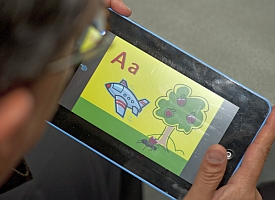Researchers have tested in India an electronic tablet device designed in the U.S. and Singapore for widespread use in Indian schools. The I-slate is being developed at the Institute for Sustainable and Applied Infodynamics (ISAID), a joint program of Rice University in Houston, Texas and Nanyang Technological University (NTU) in Singapore.
The device, still a prototype, is known as the I-slate, a hand-held electronic tablet containing pre-loaded dedicated applications with lessons in various subjects. For mathematics, students use a stylus to tap and write out problems on the I-slate, and get immediate feedback about correct and incorrect answers. When answers are incorrect, the machine gives hints and tips about how to correct mistakes.
In March, the I-slate was tested in a class of 10- to 13-year-olds at Mohd Hussainpalli village, about 70 miles southwest of Hyderabad, India, with researchers focusing on the extent students learned math with the device. A team from ISAID, working with the Indian nonprofit Villages for Development and Learning Foundation (ViDAL), analyzed each student’s performance and improvement. Students were also surveyed about the features of the I-slate that were most and least useful.
Krishna Palem, director of ISAID and professor at both NTU and Rice, says the tests and surveys confirmed the device was effective and provided the ISAID team with valuable information needed to finalize the I-slate’s design. “We’ve settled the hardware questions,” says Palem, “and that is central to the manner in which the lessons are taught and the manner in which the students interact with the I-slate.”
The production version of the i-Slate is expected to have a low-power processor chip that can run on solar energy, much like many handheld calculators, and cost less than $50.00. ISAID team members in Switzerland, Singapore, and the U.S. are developing the first production version of the low-power computer chip. Solar-powered I-slates containing the new chips are due for production in mid-2012.
Because of the low-power requirements, both the hardware and graphic content for the I-slate must be developed in tandem. Palem says a Los Angeles-based consortium of media and content developers is putting the finishing touches on the math, science and social studies curriculum, which will be pre-loaded on the production version of the I-slate.
Another test of the battery-powered version with traditional chips is scheduled for fall of 2011. This test, with 50 students in Mohd Hussainpalli and other nearby villages, will assess the curriculum and final design for about six months.
The following video from Rice and NTU tells more about I-slate and shows the device in use in India.
Read more: One Nation, Under Geeks
* * *


 RSS - Posts
RSS - Posts
You must be logged in to post a comment.